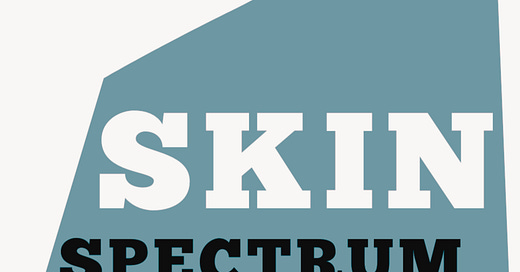Melanoma in New Zealand Māori
Rising skin cancer rates, poorer prognosis, and gaps in data collection face the Indigenous population in New Zealand (Issue #243, 1,500 words, 7 minutes)
Rates of melanoma skin cancer among the Māori population are growing in New Zealand, the nation with the highest melanoma mortality rate in the world. As with many other darker-skinned populations, the Māori tend to present later, with greater Breslow thickness and have poorer outcomes. However, research in this population faces several challenges.
This message was part of a presentation by Dr. Monique Mackenzie (Ngāti Tūwharetoa) at the first-annual Indigenous Skin Spectrum Global Summit, which was held on April 5, 2025, in Montreal.
Dr. Mackenzie is a Consultant Dermatologist at Skin Centre, Tauranga, New Zealand. She is the first Indigenous Māori Dermatologist in New Zealand. She has worked in Australia and the United Kingdom and has been involved in many initiatives to help grow Indigenous knowledge (Mātauranga Māori) and language (Te Reo Māori) in dermatology.
She said there had been a 4.3% increase in the age-standardized rate of melanoma in New Zealand’s Māori between 2000 and 2021.
A study published in the World Journal of Surgery (Aug. 2010; 34(8):1788-1792) found that Māori patients showed a greater Breslow thickness at the time of diagnosis as well as a later presentation. “Breslow thickness also increased with age and was quite significant over the age of 70,” Dr. Mackenzie said. There were also significantly poorer survival outcomes.
Also, the distribution of melanoma showed it occurred more frequently on non-sun-exposed sites, and acral melanoma was of much greater incidence than in patients of European ancestry.
Dr. Mackenzie said there is a 156% excess melanoma mortality percentage for the Māori population compared to their European counterparts. She identified several factors that may contribute to that finding:
Poor access to health care and private health insurance
Existing socio-economic disparities
A lack of education in detection among both patients and healthcare providers
A misperception in the community that having a darker skin type protects you from skin cancers
There is an acute lack of clinical research in this population
“Data collection has been fraught in New Zealand,” said Dr. Mackenzie. “That's mainly around deciding on a definition for different ethnic groups. Historically, it's been inaccurately collected. Only about one in five Māori were documented as being Indigenous Māori with their national health index numbers.” She noted there is no accurate count of non-melanoma skin cancers in New Zealand’s Māori population.
Bottom line: Rates of melanoma among New Zealand’s Indigenous Māori population are growing, while the nation already has the highest rate of melanoma mortality in the world. Similar to many darker-skinned populations, the Māori tend to present later, with thicker melanomas, and the acral form of the cancer is more common. Healthcare resource limitations and challenges with data collection complicate research in this field.
From the literature on skin cancer in skin of colour
Skin cancer risk across racial and ethnic groups among solid organ transplant recipients in the United States, 2000 to 2022
For this cohort study, researchers included solid organ transplant recipients (SOTRs) in the U.S. between Jan. 1, 2000, and Sept. 30, 2022. The investigators obtained data from the United Network for Organ Sharing (UNOS) database.
The authors compared rates of post-transplant squamous cell carcinoma (SCC), basal cell carcinoma (BCC), and melanoma among six self-reported racial or ethnic groups.
The final analysis included 696,076 SOTRs (38% female) and represented a racially/ethnically diverse cohort (38% non-White).
White, non-Hispanic SOTRs had incidence rates (IRs) per 100,000 person-years of 1,113 (95% confidence interval (CI): 1,101, 1,126), 615 (95% CI: 606, 624), and 93 (95% CI: 90, 97) for SCC, BCC, and melanoma, respectively. Non-White SOTRs had significantly lower IRs of all analyzed skin cancers (p<0.01). Hazard ratios for SCC, BCC, and melanoma ranged from 0.05 (95% CI: 0.05, 0.06), 0.02 (95% CI: 0.01, 0.02), and 0.03 (95% CI: 0.02, 0.05), respectively, among Black recipients, to 0.25 (95% CI: 0.20, 0.31), 0.18 (0.12, 0.26), and 0.25 (95% CI: 0.11, 0.55), respectively, among American Indian or Alaska Natives. Skin-cancer-attributable death occurred in 0.08% (356/432,017) of White, non-Hispanic recipients and 0.00% (9/264,059) non-White (p<0.01).
The authors say their findings align with a 2019 Delphi consensus that considers race-specific risk factors and stratifies groups for skin cancer screening into three risk categories: (1) high-risk Caucasian, (2) low-risk Caucasian, Hispanic, Asian, and high-risk Black, and (3) low-risk Black. This study’s findings support adding Native Americans, Alaskans, and Pacific Islanders to the second risk category.
The use of artificial intelligence for skin cancer detection in Asia: A systematic review
Researchers systematically reviewed the PubMed and EMBASE databases to summarize the existing use of artificial intelligence for skin cancer detection in Asian populations.
The investigators included articles published regarding the use of artificial intelligence for skin cancer detection in Asian populations, collecting information regarding study characteristics, AI model characteristics, and outcomes.
The authors of this open-access paper found that current studies show optimistic results in utilizing AI for skin cancer detection in Asia. However, comparing image recognition abilities might not accurately represent the diagnostic abilities of AI versus dermatologists in the real world. The researchers conclude that to ensure the appropriate implementation of AI, maximize the potential of the tools, and improve the transferability of AI models across various Asian genotypes and skin cancers, researchers must focus on prospective, real-world-based practice. The expansion and diversification of existing Asian databases used to train and validate AI models is also crucial.
Melanoma skin cancer statistics derived from 7,442 Japanese patients: Japanese melanoma study
Researchers analyzed data from 7,442 Japanese melanoma patients collected between 2005 and 2022 through the Japanese Melanoma Study (JMS). The investigators evaluated demographic, clinical, and survival data, including subtype distribution, TNM staging, and treatment outcomes.
Acral lentiginous melanoma (ALM) was the most common subtype (40.8%), followed by superficial spreading melanoma (20.2%). Investigators observed lymph node metastasis in 28.6% of cases and distant metastasis in 10.9%. The BRAF mutation rate was 27.2%, with significantly lower frequencies in ALM (8.5%) and mucosal melanoma (4.8%). Among Stage IV patients, those treated with both immune checkpoint inhibitors (ICIs) and BRAF(+ MEK) inhibitors demonstrated significantly improved survival compared to chemotherapy alone (p<0.05). Adjuvant BRAF(+ MEK) inhibitor therapy also resulted in superior relapse-free survival compared to those who did not receive adjuvant therapy (p<0.005).
In their conclusions, the authors note the lower BRAF mutation rates and the limited efficacy of current ICI treatments in this population, emphasizing the urgent need to optimize immunotherapy strategies in Japanese melanoma patients.
At the intersection of skin and society
CBC News reports that Indigenous legal advocates in northwestern Ontario are concerned that the Ontario government's cancellation of its contract with the Starlink satellite internet provider may impair access to legal services in remote First Nations.
In March 2025, Ontario Premier Doug Ford announced the province would cancel the $100-million deal with Elon Musk's internet provider, as a retaliatory measure in the ongoing Canada-U.S. trade war.
Starlink is a low-orbit satellite constellation system that improves broadband internet access in rural and remote communities.
In northwestern Ontario, this means the end of the Starlink-Navigator Program delivered by Nishnawbe-Aski Legal Services Corporation (NALSC), which "permitted community members, who often do not have access to internet, or reliable internet, an opportunity to participate in virtual courts."
NALSC serves people across Nishnawbe Aski Nation (NAN) territory, which covers 49 First Nations across Treaties nine and five. The Starlink-Navigator Program allowed the organization to assist between five and 80 people in attending virtual court per session across 29 court locations.
“Going forward, NAN community members will need to independently find the means and technology to attend court via Zoom,” NALSC said in a statement on April 8, 2025.
The organization, which declined an interview with the CBC, issued a follow-up statement on April 10, providing more details about the Ministry of the Attorney General's refusal to renew funding for the program.
“Without funding to this critical program, it is anticipated that, alongside ancillary effects, many individuals will be unable to participate in the court process when their respective court is proceeding virtually,” NALSC said in the April 10 release.
“A lack of funding for the Starlink-Navigator Program will further strain an already overburdened legal system. Communities should expect to see an increased cost to complete matters, as the inability to facilitate virtual court appearances will delay legal proceedings.”
This week
May is Asian Heritage Month in Canada
May 1 is National Physicians’ Day in Canada
May 3 is World Press Freedom Day
Something to think about in the week ahead . . .
—Nicolas Chamfort, (1741-1794), French writer
Next Week
Researchers from Germany discuss the importance of and challenges of developing diverse, representative virtual agents for dermatology training.
Register now for the 3rd annual Summit on Atopic Dermatitis
The 2025 Summit on Atopic Dermatitis virtual conference will be held on May 10.
Chaired by Dr. Marissa Joseph (Toronto), the Summit on Atopic Dermatitis will address the unmet need for education among healthcare providers on the incidence of AD and the latest therapies.
Date: Saturday, May 10, 2025
Time: 10:00 AM to 1:00 PM ET
Location: Virtual (Zoom)
Cost: Free of charge
What to Expect
Gain insights from leading experts and explore current trends and emerging treatment options in dermatology
Learn effective case management strategies for both children and adults through interactive sessions and live Q&As with dermatologists and primary care professionals
Engage in expert-led discussions that address real-world applications and focus on inclusive approaches across diverse patient groups
If you enjoy Skin Spectrum Weekly, why not check out the Chronicle’s other publications, podcasts, and portals?
Established in 1995, The Chronicle of Skin & Allergy is a scientific newspaper providing news and information on practical therapeutics and clinical progress in dermatologic medicine. The latest issue features:
Dr. Ruth Ann Vleugels (Boston) describes emerging treatments for dermatomyositis associated with lupus.
Drs. Charles Lynde (Markham, Ont.), Fiona Lovegrove (London, Ont.), Julien Ringuet (Quebec), and Kerri Purdy (Halifax) review new dermatologic therapies to watch in 2025.
Dr. Susan Poelman (Calgary) summarizes current research into treatments for hidradenitis suppurativa and discusses why physicians should be optimistic about the future of managing this disease.
Plus regular features, including the popular column “Vender on Psoriasis” by dermatologist Dr. Ron Vender.
You can read a recent digital edition of The Chronicle of Skin & Allergy here. To apply for a complimentary subscription or to request a sample copy, please email health@chronicle.org with your contact information.
The Women in Dermatology e-newsletter updates readers with new findings concerning dermatologic issues affecting women and the female dermatologists who care for them. Read the current issue here.
Season three of the Vender on Psoriasis podcast with Dr. Ron Vender has begun. Listen to the new season here. In episode five, Dr. Vender discusses whether vitamin D influences psoriasis severity, sex differences in psoriatic inflammation itch, and the risk of psychiatric disorders associated with acitretin.
And if you’re looking for a web destination for all things derm, visit derm.city, “Where Dermatology Lives.” Please like, rate, review, and share it with your colleagues.
You are receiving this newsletter because you subscribe to The Chronicle of Skin & Allergy or another Chronicle journal, have attended a Skin Spectrum Summit live event or webinar, or have previously requested a subscription to one of our newsletters. If you no longer wish to subscribe to this newsletter, please email the subject line “Unsubscribe Skin Spectrum Weekly” to health@chronicle.org.
Skin Spectrum Weekly is published by Chronicle Companies, 701 Ellicott Street, Buffalo, NY 14203. Canada: 1460 The Queensway, Suite 212, Toronto, Ont. M8Z 1S4
Mitchell Shannon, Publisher; R. Allan Ryan, Editorial Director; John Evans, Managing Editor; Jeremy Visser, Editor; Cristela Tello Ruiz, Client Services; Shannon Abbott, Associate Conference Organizer
Content is copyright (c) 2025, Chronicle LifeSci America Corp, except as indicated. Interested in contributing to this newsletter or learning more about Chronicle’s services? Please write to us at health@chronicle.org
Skin Spectrum Weekly is a reader-supported publication. To receive new posts and support my work, consider becoming a free or paid subscriber.










